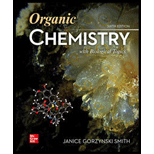
Concept explainers
(a)
Interpretation: The most stable radical that can result from cleavage of
Concept introduction: A free radical is an atom or ion with unpaired electrons. They are reactive intermediates formed by the homolysis of covalent bond. Free radicals are classified as
(b)
Interpretation: The most stable radical that can result from cleavage of
Concept introduction: A free radical is an atom or ion with unpaired electrons. They are reactive intermediates formed by the homolysis of covalent bond. Free radicals are classified as
(c)
Interpretation: The most stable radical that can result from cleavage of
Concept introduction: A free radical is an atom or ion with unpaired electrons. They are reactive intermediates formed by the homolysis of covalent bond. Free radicals are classified as
(d)
Interpretation: The most stable radical that can result from cleavage of
Concept introduction: A free radical is an atom or ion with unpaired electrons. They are reactive intermediates formed by the homolysis of covalent bond. Free radicals are classified as
Want to see the full answer?
Check out a sample textbook solution
Chapter 13 Solutions
ORGANIC CHEMISTRY W/BIOLOGICAL TOPICS
- Examine the reactant and product for each reaction. Label each transformation as an addition, elimination, or substitution. Br А. Br ОН elimination addition С. substitution D. B.arrow_forwardDrew the mechanismarrow_forwardWhen free radical halogenation is performed with one of the compounds below, only a single product with the formula C5H11Cl is isolated. Which compound fits this description? Select one: a. 2,2-dimethylpropane b. cyclopentane c. pentane d. 2-methylbutanearrow_forward
- Why does bromination reactions occur only on more stable radicals? O a. Br₂ is less reactive than Cl₂. O b. Br₂ is more reactive than Cl₂. O c. Br₂ is less selective than Cl₂. O d. Both a and c.arrow_forward1. Which among these can make a molecule nucleophilic? a.double bondsb.positive chargec. incomplete octet 2. Which among these can make a molecule electrophilic? a.Triple bondsb.positive chargec. radicalsarrow_forwardDraw additional resonance structures for each species.arrow_forward
- Which is a better nucleophile? a. Br− or Cl− in H2O b. Br− or Cl− in DMSO c. CH3O− or CH3OH in H2O d. CH3O− or CH3OH in DMSO e. HO− or −NH2 in H2O f. HO− or −NH2 in DMSO g. I− or Br− in H2O h. I− or Br− in DMSOarrow_forwardIdentify A through H.arrow_forwardConsider this step in a radical reaction: Br Br: ?arrow_forward
- Answer all questions please with as much detail as possible!arrow_forwardWhat would be the effect on the rate of reaction if the concentration of the nucleophile weredoubled in an…a. SN1 reaction? Briefly explain.b. SN2 reaction? Briefly explain.arrow_forwardWhich B carbon in the molecule below would be used to form the Zaitsev product? Br a. A b.B C. C d. D e. E O f. F ajarrow_forward
 Organic Chemistry: A Guided InquiryChemistryISBN:9780618974122Author:Andrei StraumanisPublisher:Cengage Learning
Organic Chemistry: A Guided InquiryChemistryISBN:9780618974122Author:Andrei StraumanisPublisher:Cengage Learning
